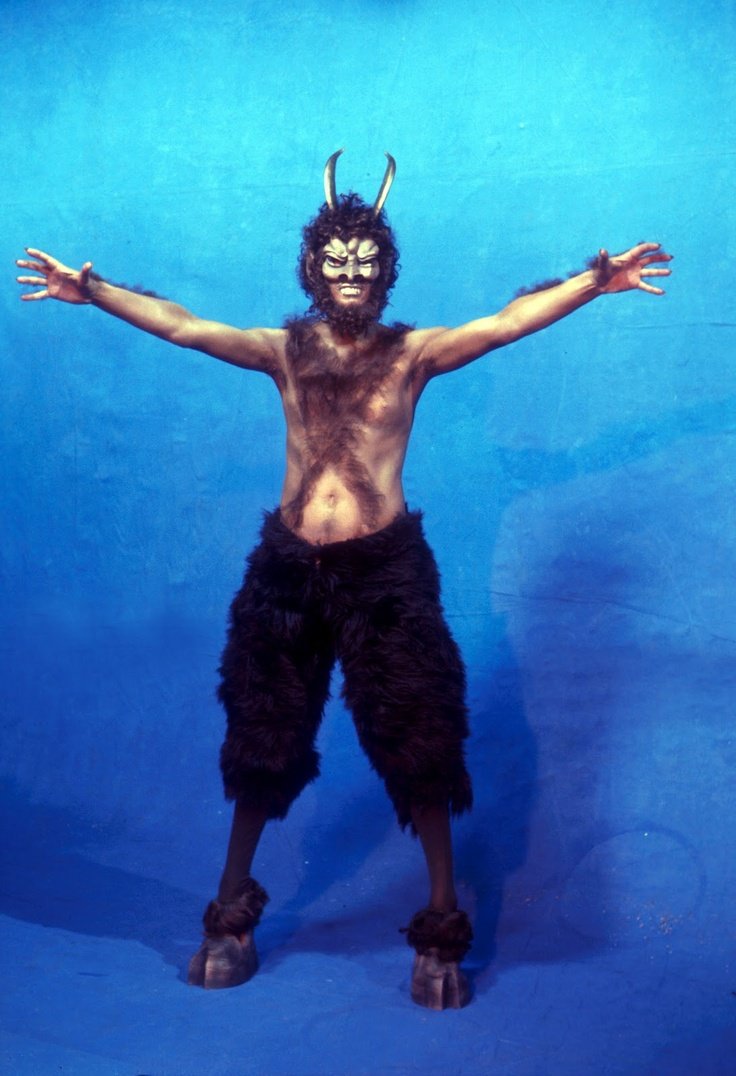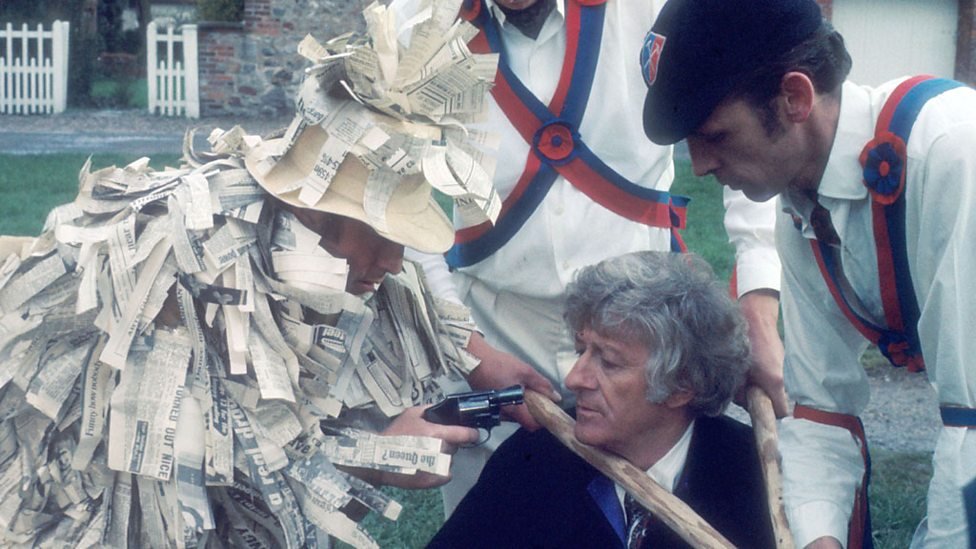Doctor Who has a history with the occult. Look at all those clans, summoning strange forces and worshipping something far from their understanding. It’s laced throughout classics like The Masque of Mandragora, The Curse of Fenric, and The Brain of Morbius, while Gods and devils have manifested themselves in tales including Pyramids of Mars, The Impossible Planet/ The Satan Pit, and The Greatest Show in the Galaxy. It seems that anything the occult touches is bound to be a classic.
And The Dæmons is certainly evidence of this.
Mastering the Devil
An old burial mound is being excavated near the village of Devil’s End and evil is brewing. And the local vicar, Mr. Magister, looks suspiciously like the Master…

It’s such an iconic image, deeply ingrained into Doctor Who fans: Roger Delgado’s Master as a vicar, holier than thou. So it’s not a great surprise when he turns up midway through episode one of the five-part story. But imagine what it must’ve been like for the 9.2 million viewers who watched its first transmission in 1971: the big reveal! The Master is back! Shock, shock, horror, horror!
Or not. Doctor Who Season 8 features the Master very heavily, actually. He originally turned up in the Robert Holmes-penned Terror of the Autons, but the Doctor’s ‘rival’ Time Lord then cropped up in the three following stories – The Mind of Evil, The Claws of Axos, and Colony in Space – before The Dæmons. The Master, wonderfully portrayed by Roger Delgado, appeared in every single storyline of Season 8, before the production team realised it was overkill… and sent him to prison!
The Master received a well-deserved break from the series for two serials, Day of the Daleks and The Curse of Peladon, before returning in The Sea Devils, taking over the jail using his hypnotic skills.
And it’s arguably the Master who shines above all in The Dæmons. In a previous issue of Doctor Who Magazine, Gary Gillatt mentioned that “the Doctor has a chip on his shoulder throughout.” Jo, arguably, is well characterised, but doesn’t play much of a part in events until the last episode. UNIT, including the Brigadier at the top of his game, are sidelined for quite some time, providing a fun bit of padding as they try to get through a heat barrier.
The Master, meanwhile, is… well, masterly.
Who’s that Guy?

But all the guest characters are fleshed out beautifully. Miss Hawthorne may be a stereotypical white witch, but she’s played with gusto by Damaris Hayman. Alistair Fergus, the BBC3 reporter, is wonderful as he locks horns with archaeologist, Professor Horner, while trying to create a sense of melodrama for his viewers. Even Jim, the man we see walking his collie at the beginning, is pitched well as he strolls through the graveyard and comes face-to-face with something terrifying. We never do find out what happened to his dog…
Aside from the sterling performances, credit must go to the writer, Guy Leopold, with The Dæmons as his sole Doctor Who work. Sort of.
Guy Leopold, of course, doesn’t exist; he is, in fact, a pseudonym for Barry Letts and Robert Sloman, slotting into a long line of fake names associated with the show. The Master was always being credited as someone else; Terry Molloy was credited as Roy Tromelly in Remembrance of the Daleks; while, more recently, companions have auditioned for roles under codenames: Karen Gillan, for instance, was originally up for a role in Panic Moon (the anagram addicts amongst you will quickly work out that it means ‘companion’), and Pearl Mackie’s was Mean Town. Andy Pryor, casting director, revealed:
“It’s an anagram of ‘Ten Woman’. Series 10, and also the tenth companion of the modern series… These anagrams are becoming harder to think of but they’re always fun. It’s really so that nobody reads an email over someone’s shoulder and the name pings out at them.”
My favourite, however, is The Brain of Morbuis writer, Robin Bland, a creation of Robert Holmes after Terrance Dicks was unhappy with re-writes and requested it be aired under a ‘bland pseudonym.’ Personally, whenever I hear ‘Guy Leopold,’ I recall The Simpsons (“Homer? Who is Homer? My name is Guy Incognito”).
Sloman was approached by Letts in 1972, 10 years after the former’s play, The Tinker, was turned into a movie, The Wild and the Willing. The two were friends, and The Dæmons was the first they wrote for Doctor Who. The pair continued to write together (with Letts remaining uncredited), collaborating on The Time Monster, The Green Death (writing out Katy Manning’s Jo Grant), and Planet of the Spiders, which of course brought the Third Doctor’a era to a close.
Barry Letts was producer of the Third Doctor’s era (1970- 74), then the Fourth Doctor’s introductory tale, Robot, before returning for a final time on Logopolis, alongside John Nathan-Turner. He also directed six serials, including The Enemy of the World – which was recovered for the show’s 50th anniversary – Carnival of Monsters, and The Android Invasion. Though he died in 2009, Letts’ influence is still felt today.
A Matter of Perspective

The Dæmons makes many horror allusions, most obviously a horned beast and a worship of the occult. An unearthly wind echoes through the village and they are all trapped in an idyllic (yet somehow sinister) location. A few, including the Time Team crew in the latest issue of the Doctor Who Magazine – commented that 2010’s The Hungry Earth/ Cold Blood felt like it came straight from the Jon Pertwee era. Overlooking the obvious link – the Silurians, Eocenes, or Homo Reptilia, whatever you want to call them – Cwmtaff is sealed off, much like Devil’s End.
(The current Doctor, Peter Capaldi, has often been called akin to the Third Doctor, but beyond his red-lined jacket, is there substance in this? In the Forest of the Night had environmental issues at its heart, and The Zygon Invasion/ The Zygon Inversion was very political, but there’s no further substantial links between these eras just yet. Maybe Series 10…? Hmm. Maybe that Osgood is named after )
Of course, much of this revolves around the idea of magic as alien technology; not wizardry, but something beyond human understanding. The notion is revisited in Image of the Fendahl, Battlefield, and The Shakespeare Code. Turlough got locked up for ‘conjuring demons’ in King John of England’s court in The King’s Demons; indeed, the supposed King was a little obsessed with calling the Doctor and co. demons.
In The Dæmons, the Doctor is accused of using magic too, leading him to be tied to a maypole, and sentenced to death, mimicking the practice of burning witches. The Sycorax also accused the Doctor of witchcraft after he regenerated his hand in The Christmas Invasion, to which he replies: “Time Lord.” This denial is quite different to the Doctor’s initial reaction in The Dæmons, calling himself “the Great Wizard Quiquaeqoud.” (The in-joke here? ‘Qui,’ ‘quae,’ and ‘quod’ are, respectively, the masculine, feminine and gender-neutral forms of ‘who’ in Latin.)
Oh, Bok

It’s these effective horror clichés that make The Dæmons such a memorable classic. And as Captain Yates says: “All we’ve got to deal with is something which is either too small to see or 30 feet tall, can incinerate you or freeze you to death, turn stone images into homicidal monsters, and looks like the devil.” Yes, Mike – exactly. Easy.
It’s just a shame no one knows how to pronounce the story’s title…
(Adapted from an article originally published on Kasterborous in April 2012.)
